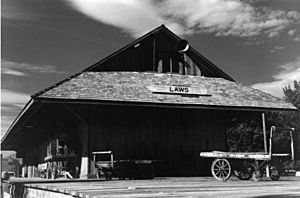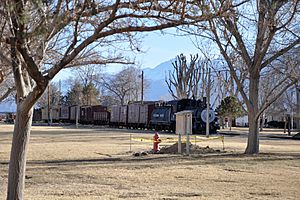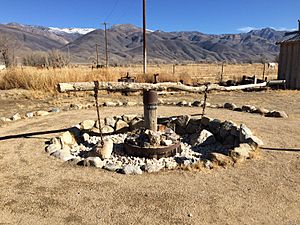Laws, California facts for kids
Quick facts for kids
Laws
|
|
|---|---|

Laws station in 1998
|
|
| Country | United States |
| State | California |
| County | Inyo County |
| Elevation | 4,117 ft (1,255 m) |
| Time zone | UTC-8 (Pacific Time Zone) |
| • Summer (DST) | UTC-7 (PDT) |
| ZIP Code |
93514
|
| Area code(s) | 760 |
| GNIS feature ID | 1659742 |
| Official name: Laws Station | |
| Reference #: | 953 |
Laws is a small community in Inyo County, California. It was once known as Station and Bishop Depot. Laws is about 4 miles (6.4 km) northeast of Bishop. It sits along U.S. Route 6, heading towards the Nevada state line.
Contents
Laws, California: A Historic Town
Laws is located in the beautiful Owens Valley. To its east are the White Mountains. To the west are the towering Sierra Nevada Mountains, often called the "Eastern Sierras." The Owens River flows nearby.
The History of Laws
The town of Laws began in 1883. It was first called Station and served as a stop for the Carson and Colorado Railroad. Later, its name changed to Laws to honor R.J. Laws, a railroad official. A post office operated here from 1887 until 1963. Laws was an important railroad station for a narrow gauge railway. This type of railway uses tracks that are closer together than standard tracks.
Today, Laws is a special place. It is a museum that shows the history of the Owens Valley and the Eastern Sierra Nevada. It is recognized as California Historical Landmark #953.
Laws Railroad Museum and Historic Site
The Laws Railroad Museum and Historic Site is a popular attraction. In 2015, a travel website called Atlas Obscura named it one of 160 "international gems."
Exploring the Railroad Displays
At the museum, you can see old trains. There is a steam locomotive called Southern Pacific 9. It used oil for fuel. You can also see several freight cars. These trains were part of the Southern Pacific Railroad's narrow gauge lines. The museum explains that these railroads were vital for many communities. They helped people travel and move goods before modern roads were built in the 1950s and 1960s.
You can also visit the home of the old station agent. Volunteers often dress up as the agent. They help visitors imagine what life was like long ago.
Discovering Owens Valley History
The museum also has many historic buildings. These buildings were moved from downtown Bishop. You can see an old church and a school house. There is even a 1949 ambulance on display. It was later painted black and used as a hearse. You can also see medical tools from a local doctor's office. A wooden Western Electric type 11 telephone booth is also there.
The museum teaches about the history of the Owens Valley. It explains the building of the Los Angeles Aqueduct. This project, also called the "Owens Valley Aqueduct," moved water to Los Angeles. Today, the land around the museum belongs to the Los Angeles Department of Water and Power.
Displays show that the Valley once had large farms. This was true from the time of the Paiute Native Americans. It continued through the pioneer days. Then came the "water wars era" in the early 1900s. During this time, water was sent to Los Angeles. Museum guides share old photos. They explain how the valley changed.
Mining History Exhibits
The museum also has many old mining tools. Some of these tools have been rebuilt by volunteers. One example is an arrastra. This was a simple machine used to crush rocks.
An arrastra was made from natural materials. It had a long log, like an elm tree branch. This log was rotated by people or animals. Heavy stones were attached to the log. As the log turned, the stones dragged over rocks containing valuable ore. This process broke the rocks apart. It exposed the ore inside. It was very hard work before machines took over.
Government Representation
Laws is part of different government districts. In the California State Legislature, it is in Senate District 8. It is also in Assembly District 26. For the United States House of Representatives, Laws is in Congressional District 8.
Related Topics
- Bishop, California
- California Water Wars
- Owens River
- Inyo National Forest




